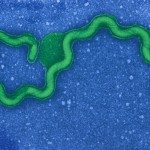Link to Pubmed [PMID] – 29310748
Microb Genom 2018 Jan;
Despite recent advances in our understanding of the genomics of members of the genus Leptospira, little is known on how virulence has emerged in this heterogeneous bacterial genus as well as on the lifestyle of pathogenic members of the genus Leptospira outside animal hosts. Here, we isolated 12 novel species of the genus Leptospira from tropical soils, significantly increasing the number of known species to 35 and finding evidence of highly unexplored biodiversity in the genus. Extended comparative phylogenomics and pan-genome analyses at the genus level by incorporating 26 novel genomes, revealed that, the traditional leptospiral ‘pathogens’ cluster, as defined by their phylogenetic position, can be split in two groups with distinct virulence potential and accessory gene patterns. These genomic distinctions are strongly linked to the ability to cause or not severe infections in animal models and humans. Our results not only provide new insights into virulence evolution in the members of the genus Leptospira, but also lay the foundations for refining the classification of the pathogenic species.

